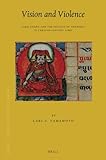Vision and violence : Lama Zhang and the politics of charisma in twelfth-century Tibet / by Carl S. Yamamoto.
Material type: TextSeries: Brill's Tibetan studies library ; v. 29.Publication details: Leiden : Brill, 2012.Description: 1 online resourceContent type:
TextSeries: Brill's Tibetan studies library ; v. 29.Publication details: Leiden : Brill, 2012.Description: 1 online resourceContent type: - 9789004230101
- 9004230106
- 9781280688140
- 1280688149
- Zhang Gʹyu-brag-pa Brtson-ʼgrus-gʹyung-drung, 1123-1193
- Zhang Gʹyu-brag-pa Brtson-ʼgrus-gʹyung-drung, 1123-1193
- Bkaʼ-brgyud-pa lamas -- Biography
- Buddhism and politics -- China -- Tibet Autonomous Region -- History
- Lamas bka'-brgyud-pa -- Biographies
- Bouddhisme et politique -- Chine -- Région autonome du Tibet -- Histoire
- RELIGION -- Buddhism -- Tibetan
- Bkaʼ-brgyud-pa lamas
- Buddhism and politics
- China -- Tibet Autonomous Region
- 294.3/923092 B 23
- BQ999.A37 Y36 2012
- online - EBSCO
| Item type | Current library | Call number | URL | Status | Notes | Barcode | |
|---|---|---|---|---|---|---|---|
 eBook
eBook
|
Biblioteca "Angelicum" Pont. Univ. S.Tommaso d'Aquino Nuvola online | online - EBSCO (Browse shelf(Opens below)) | Online access | Not for loan (Accesso limitato) | Accesso per gli utenti autorizzati / Access for authorized users | (ebsco)460912 |
Browsing Biblioteca "Angelicum" Pont. Univ. S.Tommaso d'Aquino shelves, Shelving location: Nuvola online Close shelf browser (Hides shelf browser)
This book examines the life of Lama Zhang, key figure in the "Tibetan renaissance"--A tantric master and literary innovator who forged a new model of rulership and community that would set the standard for later religious rulers of Lhasa.
Includes bibliographical references and index.
Preface; Acknowledgments; Introduction: Picking up the Pieces: Lama Zhang and The "Tibetan Renaissance"; I. Sgam po pa's Hat; II. "Tibet in Pieces"; III. The Buddhist Revival and the Rise of the Dwags po Bka' brgyud pa Order; IV. Lhasa in the Twelfth Century; V.A Sketch of the Life; VI. Lama Zhang's Afterlife; A. In Tibet; B. In Scholarship; VII. Methodological Considerations; A. Hegemony; B. Charisma; C. Style; VIII. Sources; Chapter One Lama Zhang's Life; I. Sources for Lama Zhang's Life; A. Works Written by Lama Zhang.
B. Works Written by Zhang's Immediate Disciples and ContemporariesC. Works Written by Later Authors; II. The Life; A. Birth and Childhood; B. Early Education; C. Destructive Magic and the Life Turnarounds; D. Meetings with Key Teachers; E. Meeting with Sgom tshul and Realization of Mahamudra; F. Cultivation of Realization; Meditative Attainments; G. Public Life; H. Last Years and Death; Chapter Two Lineage and Style: Placing Lama Zhang in the Tradition; I. Was Lama Zhang a Bka' brgyud pa?; A. Sect and Lineage; B. Lama Zhang's Lineages; C. The Formation of Traditions.
II. Lama Zhang's Religious StyleA. Chos lugs: Style vs. System; B. The Elements of Lama Zhang's Religious Style; Chapter Three "To Tell Your Own Story Yourself ": Autobiography, Genre Families, and Textual Economies; I. Gyatso on the Historical Conditions for Autobiography in Tibet; A. The Collapse of the Tibetan Empire and the Reconstitution of Tibet as a Buddhist Culture; B. New Strategies of Legitimation; New Modes of Recognition and Self-Presentation; New Forms of Literature; II. Textual Economies and the Birth of Genres; A. Textual Economies; B. Genre Families.
Chapter Four "Lord of the Teachings"I. The Two Career Paths; II. "Lord of the Teachings," "Protector of Beings"; A. Who Was Fighting?; B. "The Yoke, the Law, and the Seals"; III. Public Works; A. The Works; B. Marking Territory, Sacred and Political; Chapter Five "Great Meditator Who Tears Down Forts"; I. Conflicts and Fighting; A. Reasons for Fighting; B. Some Sites of Fighting; II. "Fierce Activities": the Question of Tantric Justifications; A. Vision and Violence; B. Lama Zhang as a Virtual Object; III. Voices Against Lama Zhang; A. "Eulogizing" Lama Zhang; B. Humor and Rhetoric.
C. Reining in the WildmanConclusion: Mastering Space, Time, Symbol: Lama Zhang and the Buddhist Hegemonization of Central Tibet; I. Sectarian Groups and the Institution of the Lama; A. Hegemony and Charisma; B. The Spatial Dimension: Spread and Densification; C. The Temporal Dimension: Lineage and the Formation of Traditions; D. The Symbolic Dimension: Territory, Tradition, Text, and Identity; II. "Lord of the Teachings" Revisited; Appendices; Appendix One Contents and Back Matter/Colophons to Volumes 1-7 of the Shedup-Namgyal 2004 Edition of Lama Zhang's Collected Works.
Appendix Two Lama Zhang's Root Lamas and Their Principal Teachers.
Print version record.









